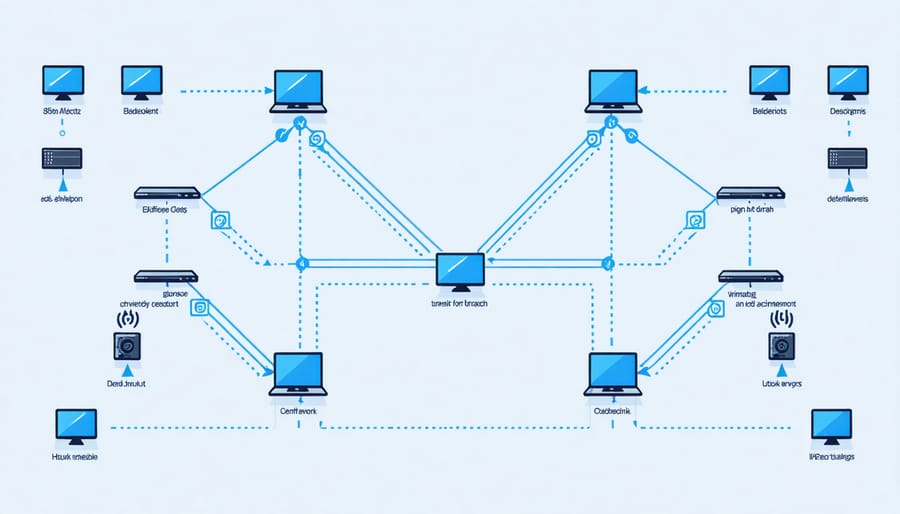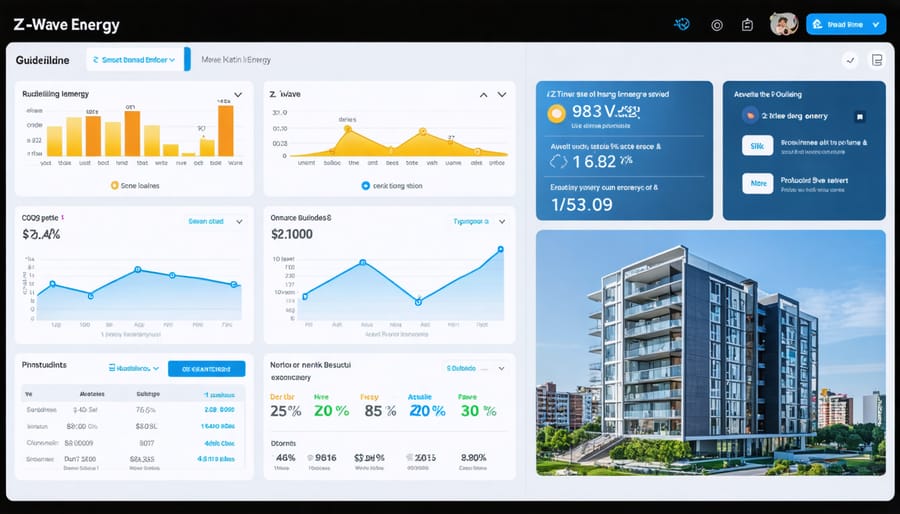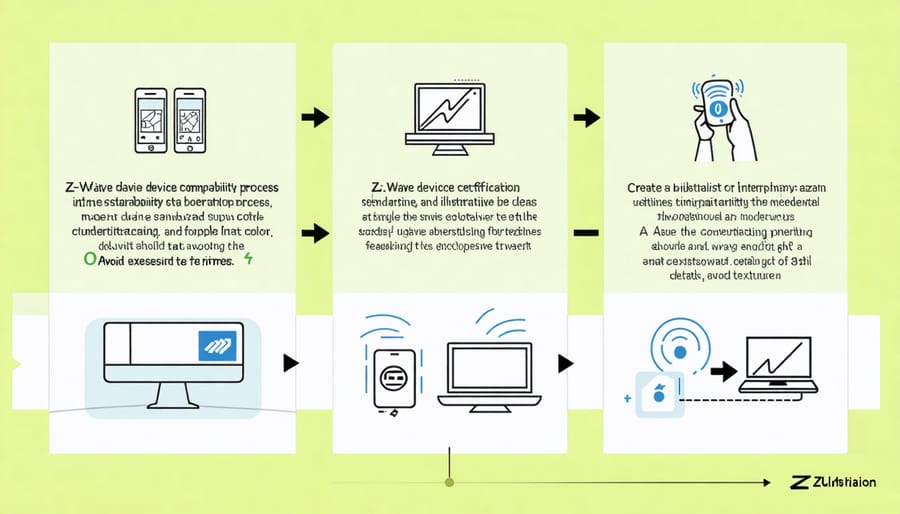Z-Wave technology stands at the forefront of smart building automation, transforming how commercial facilities operate and communicate. This wireless communication protocol enables seamless integration of devices, from lighting and HVAC systems to access controls and security equipment, creating a robust mesh network that strengthens with each added component.
Unlike traditional building automation systems, Z-Wave operates on a low-power, sub-gigahertz frequency band (908.42 MHz in North America), ensuring reliable communication through walls and floors while minimizing interference from Wi-Fi and Bluetooth devices. This strategic frequency choice makes it particularly valuable for large-scale commercial implementations where signal integrity is paramount.
For construction professionals and facility managers, Z-Wave represents a critical advancement in building technology, offering enterprise-grade security encryption, interoperability across more than 3,300 certified products, and scalability to support extensive commercial deployments. Its mesh networking capabilities ensure that each device acts as both a transmitter and repeater, creating a self-healing network that maintains functionality even if individual nodes fail.
The technology’s adoption in commercial buildings continues to accelerate, driven by its proven reliability, ease of implementation, and significant potential for reducing operational costs while enhancing occupant comfort and safety.
Understanding Z-Wave’s Technical Foundation
Mesh Network Architecture
Z-Wave’s mesh network architecture stands as one of its most significant technical advantages in commercial building applications. Unlike traditional point-to-point systems, Z-Wave devices create an interconnected network where each device acts as both a transmitter and a repeater, effectively extending the network’s range and reliability.
In this mesh topology, signals can travel multiple paths to reach their destination, routing around obstacles or interference. When one device communicates with another, the signal can hop through up to four nodes to reach its target, ensuring reliable communication even in large commercial spaces. This dynamic routing capability automatically determines the optimal path for data transmission, enhancing network efficiency and reducing latency.
The mesh architecture also provides built-in redundancy. If one device fails or loses power, the network automatically reconfigures to find alternative communication routes, maintaining system integrity. This self-healing capability is particularly valuable in mission-critical building systems where downtime isn’t acceptable.
Each Z-Wave network can support up to 232 devices, with the primary controller managing network topology and maintaining routing tables. As new devices join the network, they’re automatically integrated into the mesh, expanding coverage and strengthening the network’s overall performance. This scalability makes Z-Wave particularly suitable for large-scale commercial deployments, from office complexes to industrial facilities.
The mesh network design also optimizes power consumption, as devices can communicate through shorter distances to their nearest neighbors rather than attempting long-range direct connections.

Radio Frequency Communication
Z-Wave operates in the sub-1GHz frequency range, specifically utilizing 908.42 MHz in North America and varying frequencies between 865.2 MHz and 926.3 MHz in other regions. This strategic frequency selection ensures minimal interference from common household devices like Wi-Fi routers and Bluetooth equipment, which typically operate in the 2.4 GHz band.
The technology employs source-routed mesh networking architecture, where each device acts as both a receiver and a repeater. This creates multiple communication pathways, ensuring reliable signal transmission across the building even when individual nodes fail. Z-Wave’s communication protocol supports up to four hops between devices, with each network capable of handling up to 232 nodes.
Signal transmission power in Z-Wave devices is typically limited to 1mW (0 dBm), providing an effective range of 30-100 meters in open space. In commercial buildings, where signals must navigate through walls and floors, the practical range between devices is approximately 15-30 meters. The system’s low power consumption contributes to extended battery life in wireless devices.
Z-Wave’s communication protocol incorporates AES-128 encryption, ensuring secure data transmission between devices. The protocol also features automatic channel selection and frequency agility, helping to maintain stable connections even in environments with varying levels of radio frequency interference.
Z-Wave in Commercial Building Applications
Energy Management Systems
Z-Wave technology plays a pivotal role in modern energy management systems, offering sophisticated control over building environments while optimizing energy consumption. The technology enables seamless integration with HVAC systems, lighting controls, and power monitoring devices, creating a unified platform for comprehensive energy optimization.
In commercial buildings, Z-Wave-enabled devices communicate with central management systems to adjust temperature settings, lighting levels, and equipment operation based on occupancy patterns and time-of-day scheduling. The mesh network architecture ensures reliable communication between sensors, controllers, and building automation systems, even in large facilities with complex layouts.
The system’s ability to collect and analyze real-time energy usage data allows facility managers to identify consumption patterns and implement targeted efficiency measures. For instance, Z-Wave sensors can detect unused spaces and automatically adjust HVAC settings, while smart meters provide detailed insights into peak demand periods.
Integration capabilities extend to renewable energy systems, allowing buildings to optimize solar panel utilization and energy storage systems. The technology enables dynamic load balancing, ensuring efficient distribution of power resources across different building zones and functions.
Implementation of Z-Wave-based energy management typically results in 15-30% reduction in energy costs, with some facilities reporting even higher savings. The system’s scalability allows for gradual expansion, making it suitable for both retrofit projects and new construction, while its standardized protocol ensures compatibility with future energy management innovations.

Security and Access Control
Z-Wave technology has revolutionized building security systems by providing robust, encrypted communication protocols that ensure reliable access control and security monitoring. The technology implements AES-128 encryption as standard, making it particularly suitable for sensitive commercial applications where security breaches could have severe consequences.
In access control implementations, Z-Wave devices create a mesh network that enables comprehensive coverage throughout large buildings while maintaining consistent communication between security components. Door locks, card readers, motion sensors, and surveillance cameras can be seamlessly integrated into a single, manageable security ecosystem.
The protocol’s two-way communication capability allows security administrators to receive real-time notifications and verification of access events. When credentials are presented at an entry point, the system can instantly validate permissions and maintain detailed audit logs of all access attempts, both authorized and unauthorized.
Z-Wave’s role-based access control features enable facility managers to establish hierarchical security clearances and time-based access restrictions. The system can automatically adjust security protocols based on operational hours, emergency situations, or specific security requirements. Additionally, the technology’s ability to operate on low power consumption ensures continuous security coverage even during power outages through battery backup systems.
Integration capabilities with existing security infrastructure make Z-Wave particularly valuable for retrofit projects. The protocol’s backward compatibility ensures that security investments remain viable as technology evolves, protecting long-term infrastructure investments while allowing for gradual system upgrades and expansions.
Installation and Integration Considerations

Device Compatibility
Device compatibility is a cornerstone of Z-Wave technology, ensured through rigorous certification processes managed by the Z-Wave Alliance. Every Z-Wave device must undergo comprehensive testing and certification before entering the market, guaranteeing seamless interoperability with other certified devices regardless of manufacturer or production date.
The Z-Wave certification program operates on two fundamental principles: backward compatibility and universal communication protocols. This means that even first-generation Z-Wave devices can work effectively with the latest models, protecting investments and enabling gradual system expansion.
For construction professionals and facility managers, this certification framework offers significant advantages. It eliminates concerns about vendor lock-in, allowing the integration of devices from different manufacturers while maintaining system reliability. The certification process verifies that each device adheres to strict security protocols, including AES-128 encryption, and meets performance standards for commercial applications.
Currently, over 3,300 certified Z-Wave products are available in the market, with more than 700 manufacturers participating in the ecosystem. This extensive device ecosystem spans various categories essential for building automation, including:
– Access control systems
– HVAC controls
– Lighting solutions
– Security devices
– Energy management systems
– Environmental sensors
The certification process also ensures that all devices maintain consistent performance across different environmental conditions and usage scenarios, making them suitable for diverse commercial building applications.
Network Planning
Effective Z-Wave network planning requires careful consideration of device placement and network topology to ensure optimal performance in building environments. The primary goal is to create a reliable mesh network where each device can communicate effectively with minimal interference.
Start by conducting a thorough site survey to identify potential signal obstacles such as thick concrete walls, metal structures, and electromagnetic interference sources. Strategic placement of Z-Wave devices should maintain line-of-sight wherever possible, with a maximum recommended distance of 30 meters between devices in open spaces, reduced to 15-20 meters when accounting for building materials.
Include Z-Wave Plus certified repeaters at key locations to strengthen the mesh network, particularly in areas with challenging architectural features or extensive square footage. These repeaters should be positioned to create overlapping coverage zones, ensuring redundant communication paths and eliminating potential dead spots.
Consider the network’s scalability during initial planning. While Z-Wave networks can theoretically support up to 232 devices, practical implementations typically perform best with 30-50 devices per controller. For larger installations, implement multiple controllers in different zones, ensuring each subnet operates independently while maintaining system-wide integration.
Documentation is crucial – maintain detailed network maps showing device locations, communication paths, and potential interference zones. Regular network health monitoring and performance optimization should be scheduled to maintain system reliability and efficiency over time.
Future Developments and Industry Trends
As Z-Wave technology continues to evolve, several key trends are shaping its future in the construction and building automation sectors. The upcoming Z-Wave Long Range (Z-Wave LR) specification represents a significant advancement, extending the protocol’s range up to several kilometers while maintaining backward compatibility with existing devices. This enhancement particularly benefits large-scale commercial installations and campus-wide deployments.
Industry experts anticipate increased convergence between Z-Wave and other smart building protocols, with improved interoperability becoming a central focus. The IoT sensor integration capabilities are expanding, enabling more sophisticated building management systems that can process and respond to environmental data in real-time.
Security remains paramount, and future Z-Wave developments will incorporate enhanced encryption protocols and authentication mechanisms. The Silicon Labs’ Z-Wave 800 series chipsets are paving the way for more energy-efficient devices with extended battery life, crucial for sustainable building operations.
Market analysis indicates a growing demand for Z-Wave solutions in commercial retrofitting projects, where wireless protocols offer significant advantages over traditional wired systems. The technology’s scalability and mesh networking capabilities are driving adoption in smart city initiatives and large-scale commercial developments.
Emerging trends include advanced energy management features, predictive maintenance capabilities, and enhanced integration with artificial intelligence platforms. These developments are enabling more autonomous building operations and sophisticated occupancy-based controls.
The Z-Wave Alliance’s certification program is evolving to include more rigorous testing standards, ensuring reliable performance across an expanding ecosystem of devices. This commitment to quality control is essential as the protocol gains traction in mission-critical building systems.
Looking ahead, Z-Wave technology is positioned to play a crucial role in the development of net-zero buildings and smart grid integration. The protocol’s ability to facilitate granular control over building systems, combined with its robust security features, makes it particularly valuable for future-focused construction projects seeking to achieve advanced sustainability certifications.
Industry stakeholders can expect continued innovation in device miniaturization, improved power management, and enhanced integration capabilities with cloud-based building management platforms. These advancements will further cement Z-Wave’s position as a leading protocol in commercial building automation.
Z-Wave technology represents a robust solution for modern building automation, offering secure, reliable wireless communication and seamless device interoperability. Its mesh network architecture, low power consumption, and extensive device compatibility make it an ideal choice for both new construction and retrofitting projects. For optimal implementation, we recommend starting with a comprehensive site assessment, selecting certified Z-Wave devices from reputable manufacturers, and developing a structured deployment plan. Consider factors such as network coverage, device placement, and future scalability requirements. Regular system monitoring and updates will ensure continued performance and security. With proper planning and execution, Z-Wave technology can significantly enhance building efficiency, occupant comfort, and operational control while providing a solid foundation for future smart building innovations.

